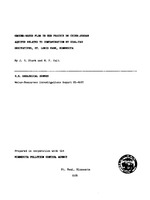Ground-water flow in the Prairie du Chien-Jordan aquifer related to contamination by coal-tar derivatives, St. Louis Park, Minnesota
Links
- Document: Report (pdf)
- NGMDB Index Page: National Geologic Map Database Index Page (html)
- Download citation as: RIS | Dublin Core
Abstract
A three-dimensional, ground-water-flow model of the Prairie du Chien-Jordan aquifer and associated hydrogeologic units was developed to evaluate the movement of coal-tar derivatives from a coal-tar distillation and wood-preserving plant in St. Louis Park, Minnesota. A finite-difference grid was superimposed on the modeled area, which includes most of eastern Hennepin County. The individual cells are 400-foot squares in the center of the grid (St. Louis Park area); the cells increase in dimension toward the outside limits of the grid. Five geologic units are represented by four layers in the model. These units include the Jordan Sandstone, the Prairie du Chien Group (dolomite and sandy dolomite), the basal confining unit of the St. Peter Sandstone (silty and sandy shale), the St. Peter Sandstone, and glacial deposits in bedrock valleys.
The model was calibrated for steady-state conditions for a period before significant ground-water development (1885-1930) and for a period of significant pumping stress (winter conditions, 1970 fs). A transient calibration was accomplished by simulation of a period during which seasonal changes in potentiometric head in the Prairie du Chien-Jordan aquifer were significant (1977-80). Sensitivity testing indicated that leakage to the upper model layer and the vertical hydraulic conductivity of the basal confining unit of the St. Peter Sandstone were the model hydrologic properties which, when changed, resulted in the greatest changes in model-calculated water levels. The calibrated model generally calculates water levels that are within 10 feet of measured values.
Model simulations indicate that the potentiometric surface of the Prairie du Chien-Jordan aquifer would be raised by as much as 3 feet in the area of the plant site by water introduced into the aquifer through wells open to more than one aquifer system. The cones of impression created at these wells could have a significant impact on the transport of contaminants in the Prairie du Chien-Jordan.
The presence of coal-tar derivatives in the aquifer has been difficult to explain in wells located upgradient from the plant site to the north, west, and southwest. Simulations suggest that, during periods of heavy withdrawal from certain of these wells (SLP10, SLP15, and SLP5), local hydraulic gradients may have been altered, resulting in the potential for the movement of contaminants from the area of the plant site to the wells. Cones of impression at multiaquifer wells near the plant site contributed to the alteration of local gradients.
Simulation of a proposed gradient-control plan, in which lateral homogeneity and isotropy of individual hydro geologic units was assumed, indicates that the actions would be effective in limiting expansion of the contaminated volume in the Prairie du Chien-Jordan aquifer. The plan includes the control of withdrawal from five wells. The simulations also show, however, that modelcalculated potentiometric surfaces are sensitive to changes in withdrawal rates at wells not intended to be under the control of the plan. Management of discharge from these wells also will be important to overall effectiveness of the remedial-action plan.
Study Area
| Publication type | Report |
|---|---|
| Publication Subtype | USGS Numbered Series |
| Title | Ground-water flow in the Prairie du Chien-Jordan aquifer related to contamination by coal-tar derivatives, St. Louis Park, Minnesota |
| Series title | Water-Resources Investigations Report |
| Series number | 85-4087 |
| DOI | 10.3133/wri854087 |
| Year Published | 1985 |
| Language | English |
| Publisher | U.S. Geological Survey |
| Publisher location | St. Paul, MN |
| Contributing office(s) | Minnesota Water Science Center |
| Description | v, 57 p. |
| Country | United States |
| State | Minnesota |
| City | St. Louis Park |
| Other Geospatial | Prairie du Chien-Jordan aquifer |
| Online Only (Y/N) | N |
| Additional Online Files (Y/N) | N |


